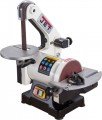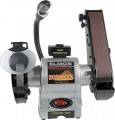Machine
Type, in other words, the general purpose of the machine.
—
Sharpening. In accordance with the name, the main purpose of such units is to sharpen the cutting edges of various tools — from knives, chisels, etc. to saw blades and chains of mechanical saws (for more details, see "Sharpening"). Such processing is carried out due to the rotation of the abrasive disc. The traditional, familiar to many grinding machine (grindstone) has two discs on the sides of the casing with the engine; however, there are often models that differ in design (especially among specialized units, for example, for sharpening chains).
—
Grinding. Grinding in the general sense is called all machines for grinding — semi-finishing and finishing of various surfaces. However, only aggregates that are not related to surface grinding are included in this category (for the latter, see below). Such machines can use different types of work items. One of the most popular options is a sanding belt mounted on two pulleys and moving due to their rotation; such a tape can be located both horizontally and vertically (“on the edge”). Another common type of work item is a disk on which sanding paper is attached. At the same time, unlike a grinding machine, the role of the working surface is played not by the edge of the disk, but by the round surface itself; this, in particular, allows you to vary the intensity of processing by moving
...the workpiece closer to the centre of the circle (where the speed of movement is lower) or vice versa. There are also combined models — for two rotation modules (see below), combining both types of work items. A separate category are spindle grinders working with sleeves (see "Working element").
— Grinding and grinding. Models that combine the capabilities of grinding and grinding machines (see above). Usually, such a unit is similar to a classic grindstone with two rotation modules, in which a sanding belt or brush is installed instead of one of the discs. Thus, both sharpening and grinding can be performed on one machine. The downside of this versatility is that both in terms of grinding and grinding capabilities, such machines are inferior to specialized models. Therefore, this option is designed mainly for situations where versatility is more important than advanced functionality.
— Grinding and polishing. Machines designed both for sharpening tools and for polishing — fine finishing of the surface of the material being processed, making it smooth and shiny. Polishing can be carried out according to the same principle as sharpening — using a rotating disk; therefore, most often machines with a polishing function are positioned as combined grinding and polishing machines. Such units are often equipped with an engraver on a flexible shaft (see below). Note that they are usually somewhat smaller than "pure" grinders, use smaller discs and are less suitable for rough work.
— Polishing. This type of machine tool is similar in design to the grinding and polishing machines described above; the key difference is that the polishers only use smooth polishing pads, and are not designed for abrasive sharpening tips (even if it is technically possible to install such a sharpening tip). Such units are less versatile than grinding and polishing units, and they do not have key advantages over them; therefore, purely polishing machines have not received much distribution.
— Surface grinding. A type of grinding machine, designed primarily for the processing of flat surfaces, including conjugated. Such aggregates are fundamentally different from the "ordinary" grinding (see above) in design and mode of operation. They use a working element in the form of an abrasive disk fixed above the desktop; this table, in turn, is fixed on a massive frame, and the workpiece on it is installed in a special fixture and moves under a rotating disk during processing. Surface grinders make it easy to process large surfaces, but they are very massive, bulky and expensive, and therefore are considered professional (and even industrial) class equipment.Motor power
Rated power of the electric motor of the machine. The more powerful the engine, the higher the speed and intensity of processing can be, the larger discs can be used with the machine and the better it is suitable for working with hard, stubborn materials. On the other hand, a powerful motor consumes a lot of energy (which may require special connection — see "Power") and significantly affects the dimensions, weight and price of the entire unit. Therefore, manufacturers choose this parameter based on the type (see "Machine") and the desired characteristics of speed, productivity, etc. In fact, this means that engine power is rather a secondary parameter, and when choosing, it makes sense to pay attention to more practical points — disk diameter, rotation / movement speed, etc.
Disc diameter
Regular diameter of the disk (see "Working element") used by the machine for dry processing (see above). When grinding and polishing, usually, we are talking about the maximum diameter of the disk that can be installed on the tool — a larger nozzle will either be ineffective or not fit into the dimensions of the seat at all, but a smaller diameter disk, usually, is installed without problems (of course, if the hole diameter matches — see below). For grinding machines, the diameter of the disc corresponds to the diameter of the sanding pad, which is necessary for the full use of the disc.
The larger the regular disk — the heavier and more powerful the machine, usually, the better it can cope with complex work of a large volume. At the same time, for small everyday tasks like periodically sharpening knives or chisels, a small disc is quite enough.
Bore diameter
The bore diameter of the dry cutting discs (see above) used by the machine. In order for the nozzle to be used normally with the machine, it must match it not only in diameter and thickness (see the relevant paragraphs), but also in the size of the mounting hole.
Disc thickness
The thickness of the "dry" blade (see "Dry Machining") for which the machine is designed. Usually, we are talking about the maximum thickness of the disc that can fit on the seat — most models allow the use of thinner nozzles.
Note that this parameter depends on the type of sharpening (see above): working with chains and saw blades involves a small thickness of the discs, universal sharpening is the opposite. And for grinding models, the thickness of the disc is not relevant at all, even if the disc is provided in the design; see "Machine" for details.
Disc speed
The nominal speed of rotation of the disk for dry processing (see above), provided by the machine; for models with adjustable rotation (see below), the maximum rotation speed.
For the same disc diameter and material, a higher speed provides more intensive processing, and a slower rotation contributes to accuracy and precision. In addition, optimal speeds depend on the composition of the disc and the material being processed; detailed recommendations with specific figures for a particular situation can be found in special sources.
A separate category is grinding machines with disk-shaped working elements: in such units, the actual speed of movement of the disk surface relative to the workpiece depends on how close the contact point is to the centre of the disk.
Belt length
The length of the belt used in a machine with grinding functions (see "Machine"), more precisely, the total length of the entire belt ring installed on the machine.
This information is necessary to select the correct sanding belts — matching in length is essential for the proper installation and operation of the attachment. In this case, the working length, usually, is more than 2 times less than the total, and to determine it, it is worth focus on the dimensions of the desktop (see below).
Belt width
Belt width for which the machine with grinding functions is designed (see "Machine"). The value of this parameter for compatibility with the tape can be different: in some models, the tape must exactly match the standard width, in others narrower tapes are allowed. From an application point of view, the larger width allows larger workpieces to be handled.
Belt rotation speed
The nominal belt speed provided by the machine with the grinding function (see "Machine"). Other things being equal, a higher speed is useful for ensuring intensity and productivity, a lower speed allows for more precise control of the process. Detailed recommendations with specific figures for a particular situation can be found in special sources.

